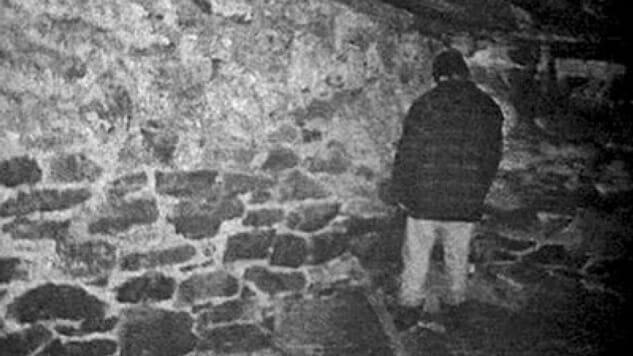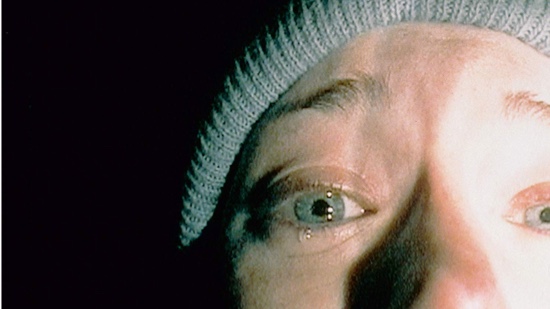Autumn Classics: The Blair Witch Project
20 years ago, indie filmmakers gave birth to found-footage horror.
Movies Features Blair Witch
As the nights get colder and the local café starts pushing pumpkin-flavored everything, many a movie lover feels the urge to stay indoors and revisit the dark, unsettling, or tragic films that evoke the spirit of the season. This October, Ken Lowe is revisiting four of these Autumn Classics. You can read up on his previous picks here.
Paste’s own Jim Vorel rightly named The Sixth Sense as 1999’s best horror film. But while M. Night Shyamalan’s story of a haunted young boy (and the spoiler who helps him) met with critical acclaim and launched that director’s career, there was one other horror sensation that year that arguably had even further cultural reach. It birthed the found-footage horror subgenre, it went “viral” in a time before things went viral, and its DNA is still present in the phenomenon that is the creepypasta community. And by dint of its gloomy backwoods setting and focus on characters menaced by dark, cold and their own paranoia in the face of the unknowable, it’s an autumn movie through and through.

Three college-age kids vanished in the woods a few years ago, the movie’s dire opening chyron informs us, and we are about to watch the footage that was recovered a year later. The movie follows ringleader Heather Donahue and reluctant cameramen Michael Williams and Joshua Leonard (all played by actors with the same names) as they attempt to gather footage for a documentary about the Blair Witch, a local legend in a small Maryland town. They first interview several local townspeople whose stories never quite line up or even seem particularly trustworthy, and then they venture into the nearby woods to find and film sites featured in the town’s grisly history.
It becomes clear fairly early on that Heather doesn’t really know what she’s doing or where she’s going, a situation that eventually leads to a breakdown in unit cohesion and the trio becoming hopelessly lost in the woods with dwindling supplies and odd and scary noises in the night that follow them around. As they fail to find their way back to civilization for days, Heather steadfastly refuses to quit filming and we get a first person view of the crew’s starvation, sleep deprivation and emotional collapse.
It isn’t until relatively late in the film that things start going bump in the night, and it begins to seem inevitable that they’ll fall into the clutches of the one spooky story that’s actually true.

Those who find the found-footage subgenre of horror to be a mixed bag (or a surefire cause of motion sickness) can point to The Blair Witch Project as the culprit. Without it, there’s no way we’d have Paranormal Activity, The Last Exorcism, V/H/S, REC, Quarantine or As Above So Below, to name a few prominent examples. Even a movie like Creep owes something to it. At their best, these are measured and effective low-budget horror with naturalistic acting and an inherent sense of unease communicated by the handheld framing. At their worst, there is no particular reason they shouldn’t just be shot as traditional narrative fiction, rather than the epistolary mess that they occasionally are.
It’s easy to forget, then, that Blair has real intentionality behind its methods. The opening scenes give the proceedings an easygoing home video vibe that the viewer just knows will be shattered. The documentary-style beginning scenes provide a number of setups that couldn’t possibly all pay off, and yet are all referenced by the end: piles of rocks foretelling murder, odd writing and the chilling final image of one of the characters huddled in a corner. Most of the time, it would all add up to a bunch of confused silliness with no particular meaning, and for years that’s really how I took it.
Consider the way the perspective is used, the point of Heather’s mission, her and her compatriots’ arrogance in carrying it out and the way those stories all rear their heads by the end, though, and a picture emerges of a group of modern know-it-alls brought low by the unknowable. “Not possible!” Heather insists when one of her cameramen says they’re lost. “This is America.”
It is America, and they are lost, and there’s no adequately explaining the thing that’s coming to get them. Mike is right about one thing: They were hosed before he ever pitched the map into the river.

The Blair Witch Project has the distinction of occupying a weird place in pop culture, not unlike the novel House of Leaves, at the very end of the analog era and the bleeding edge of the digital one. The movie’s fame arose almost entirely from word-of-mouth in a time before the internet had fully infiltrated American households. Lacking major exposure in the form of TV advertisements or trailers in theaters, a lot of people found out about it from ’zines or their one friend with negligent anarchist parents who didn’t care what their kid watched. There were rumors that the film was an actual recovered documentary and that the actors were actually deceased, and the producers tacitly let the rumors circulate. There is basically no way such shenanigans would work in the era of Facebook or Twitter, nor is it likely that such a hot film would stay under wraps for long in a time when viral marketing is its own entire industry.
More than any other entry we’ve visited in Autumn Classics so far, The Blair Witch Project captures the feeling of the outdoors in the waning months of autumn—the shoot ended on Halloween, in fact. The bizarre guerilla filmmaking methods used to steer the script-less plot—all achieved through giving the actors general cues and encouraging them to improvise—ensured that the fatigue and trauma look as real as the muddy streams and gray, sunless skies. The night scenes, where the characters unzip their tent flaps and stare into all-consuming blackness, make manifest the irrational fears every camper feels, however fleetingly, on a cold night alone in the woods.
The Blair Witch Project raked in insane box office and produced a sequel that used none of the methods the first did and was forgotten in an instant. The original, with its grainy analog sensibilities and its invisible digital reach, stands at the end of one century of horror and ushers in the next. It’s a movie without gore, without jump scares, without the bogeyman lurking in the negative space just out of the frame, with nary a Lewton bus to be seen or heard. Click through any of the creepypastas out there now, and you’ll see a whole young generation of amateur storytellers trying to capture the same unsettling feeling that lingers as the credits roll, and the movie stalks after you, out of the theater and into your room as you turn off the light.
Kenneth Lowe is so sorry. You can follow him on Twitter and read more of his writing at Escapist Magazine and at his blog. Be sure to check back for this month’s final Autumn Classic: 1979’s The Amityville Horror.